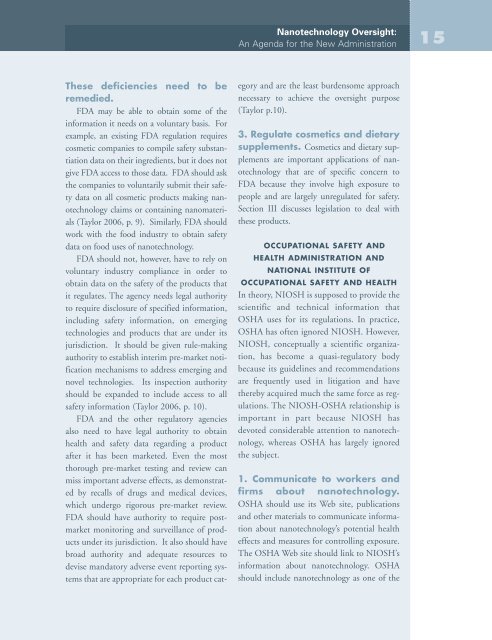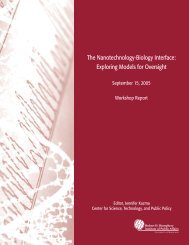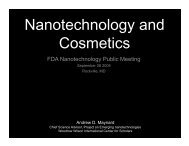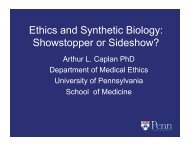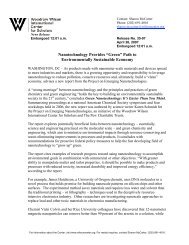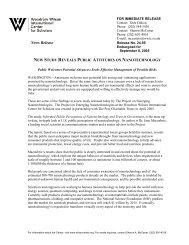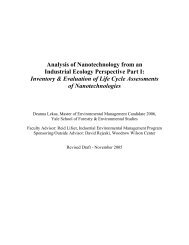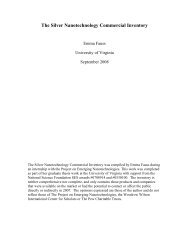nanotechnology oversight - Project on Emerging Nanotechnologies
nanotechnology oversight - Project on Emerging Nanotechnologies
nanotechnology oversight - Project on Emerging Nanotechnologies
You also want an ePaper? Increase the reach of your titles
YUMPU automatically turns print PDFs into web optimized ePapers that Google loves.
Nanotechnology Oversight:<br />
An Agenda for the New Administrati<strong>on</strong><br />
15<br />
These deficiencies need to be<br />
remedied.<br />
FDA may be able to obtain some of the<br />
informati<strong>on</strong> it needs <strong>on</strong> a voluntary basis. For<br />
example, an existing FDA regulati<strong>on</strong> requires<br />
cosmetic companies to compile safety substantiati<strong>on</strong><br />
data <strong>on</strong> their ingredients, but it does not<br />
give FDA access to those data. FDA should ask<br />
the companies to voluntarily submit their safety<br />
data <strong>on</strong> all cosmetic products making <str<strong>on</strong>g>nanotechnology</str<strong>on</strong>g><br />
claims or c<strong>on</strong>taining nanomaterials<br />
(Taylor 2006, p. 9). Similarly, FDA should<br />
work with the food industry to obtain safety<br />
data <strong>on</strong> food uses of <str<strong>on</strong>g>nanotechnology</str<strong>on</strong>g>.<br />
FDA should not, however, have to rely <strong>on</strong><br />
voluntary industry compliance in order to<br />
obtain data <strong>on</strong> the safety of the products that<br />
it regulates. The agency needs legal authority<br />
to require disclosure of specified informati<strong>on</strong>,<br />
including safety informati<strong>on</strong>, <strong>on</strong> emerging<br />
technologies and products that are under its<br />
jurisdicti<strong>on</strong>. It should be given rule-making<br />
authority to establish interim pre-market notificati<strong>on</strong><br />
mechanisms to address emerging and<br />
novel technologies. Its inspecti<strong>on</strong> authority<br />
should be expanded to include access to all<br />
safety informati<strong>on</strong> (Taylor 2006, p. 10).<br />
FDA and the other regulatory agencies<br />
also need to have legal authority to obtain<br />
health and safety data regarding a product<br />
after it has been marketed. Even the most<br />
thorough pre-market testing and review can<br />
miss important adverse effects, as dem<strong>on</strong>strated<br />
by recalls of drugs and medical devices,<br />
which undergo rigorous pre-market review.<br />
FDA should have authority to require postmarket<br />
m<strong>on</strong>itoring and surveillance of products<br />
under its jurisdicti<strong>on</strong>. It also should have<br />
broad authority and adequate resources to<br />
devise mandatory adverse event reporting systems<br />
that are appropriate for each product category<br />
and are the least burdensome approach<br />
necessary to achieve the <str<strong>on</strong>g>oversight</str<strong>on</strong>g> purpose<br />
(Taylor p.10).<br />
3. Regulate cosmetics and dietary<br />
supplements. Cosmetics and dietary supplements<br />
are important applicati<strong>on</strong>s of <str<strong>on</strong>g>nanotechnology</str<strong>on</strong>g><br />
that are of specific c<strong>on</strong>cern to<br />
FDA because they involve high exposure to<br />
people and are largely unregulated for safety.<br />
Secti<strong>on</strong> III discusses legislati<strong>on</strong> to deal with<br />
these products.<br />
OCCUPATIONAL SAFETY AND<br />
HEALTH ADMINISTRATION AND<br />
NATIONAL INSTITUTE OF<br />
OCCUPATIONAL SAFETY AND HEALTH<br />
In theory, NIOSH is supposed to provide the<br />
scientific and technical informati<strong>on</strong> that<br />
OSHA uses for its regulati<strong>on</strong>s. In practice,<br />
OSHA has often ignored NIOSH. However,<br />
NIOSH, c<strong>on</strong>ceptually a scientific organizati<strong>on</strong>,<br />
has become a quasi-regulatory body<br />
because its guidelines and recommendati<strong>on</strong>s<br />
are frequently used in litigati<strong>on</strong> and have<br />
thereby acquired much the same force as regulati<strong>on</strong>s.<br />
The NIOSH-OSHA relati<strong>on</strong>ship is<br />
important in part because NIOSH has<br />
devoted c<strong>on</strong>siderable attenti<strong>on</strong> to <str<strong>on</strong>g>nanotechnology</str<strong>on</strong>g>,<br />
whereas OSHA has largely ignored<br />
the subject.<br />
1. Communicate to workers and<br />
firms about <str<strong>on</strong>g>nanotechnology</str<strong>on</strong>g>.<br />
OSHA should use its Web site, publicati<strong>on</strong>s<br />
and other materials to communicate informati<strong>on</strong><br />
about <str<strong>on</strong>g>nanotechnology</str<strong>on</strong>g>’s potential health<br />
effects and measures for c<strong>on</strong>trolling exposure.<br />
The OSHA Web site should link to NIOSH’s<br />
informati<strong>on</strong> about <str<strong>on</strong>g>nanotechnology</str<strong>on</strong>g>. OSHA<br />
should include <str<strong>on</strong>g>nanotechnology</str<strong>on</strong>g> as <strong>on</strong>e of the


